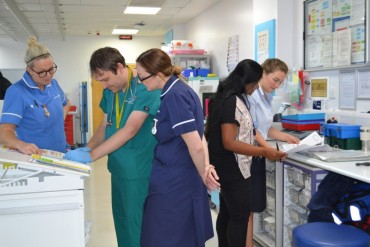An ultrasound procedure is a diagnostic procedure used to assess soft tissue structures such as muscles, blood vessels, and organs.
Ultrasound uses a transducer that sends out ultrasonic sound waves at a frequency too high to be heard. When the transducer is placed at certain locations and angles, the ultrasonic sound waves move through the skin and other body tissues to the organs and structures within it. The sound waves bounce off the organs like an echo and return to the transducer. The transducer picks up the reflected waves, which are then converted by a computer into an electronic picture of the organs or tissues under study.
Different types of body tissues affect the speed at which sound waves travel. Sound travels the fastest through bone tissue, and moves most slowly through air. The speed at which the sound waves are returned to the transducer, as well as how much of the sound wave returns, is translated by the transducer as different types of tissue.
A clear conducting gel is placed between the transducer and the skin to allow for smooth movement of the transducer over the skin and to eliminate air between the skin and the transducer for the best sound conduction.
Ultrasounds are used to view internal organs as they function (in ‘real time’, like a live TV broadcast). Ultrasound procedures are often used to examine many parts of the body such as the abdomen, breasts, female pelvis, prostate, scrotum, thyroid and parathyroid glands, and the vascular system.
Diagnostic ultrasound is a safe procedure that uses low-power sound waves. There are no direct risks from a diagnostic ultrasound exam.
Although ultrasound is a valuable tool, it does have it’s limitations. Sound doesn’t travel well through air or bone, for example, so ultrasound is not effective at imaging parts of your body that have gas in them or that are obscured by bone. Rather than using ultrasound to view these areas, your doctor might order other imaging exams such as a CT, an MRI or an X-ray to view different things.
The Sonographer or the Radiologist will ask you to lie on a table. He or she will apply some water-based gel to the area of your body that is going to be examined, so that the sound waves can be transmitted through the body and reach the scanning instrument that is placed on your skin. This instrument is called a transducer, and will be moved in different areas to view the problem from many different angles. You will be able to see the scanned images on the screen while you are having the exam performed.
You will not feel any pain during the scan. If you find it difficult or uncomfortable, please tell the Sonographer or Radiologist. The ultrasound gel will be removed with paper tissues. If your skin still feels sticky any remaining gel can be washed off with soap and water, but it also dries quickly on its own. If the Sonographer or the Radiologist gets gel on your clothes, please do not worry! The gel does not stain at all, and it just needs to be dry to become invisible again. An ultrasound scan usually takes 10-20 minutes, depending on the area of your body that is being scanned.
After the examination you can dress and leave the department. The results of your examination will not be given to you on the same day. To receive these results you will need an appointment see either the Consultant who referred you, or your own GP. You will be told after the examination which of these Doctors you need to see.



